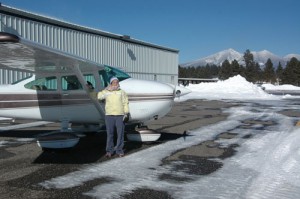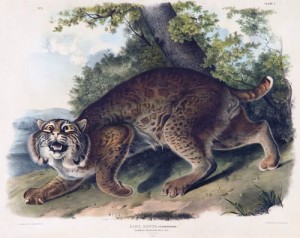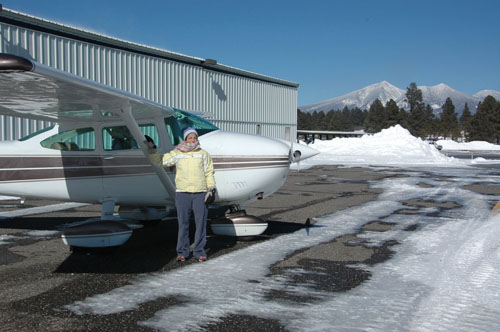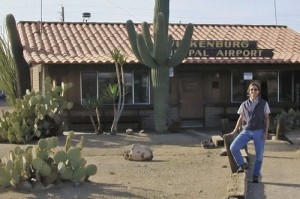
After two decades living in desert Phoenix, our new Flagstaff home reintroduced us to the winter travails suffered by other pilots elsewhere in the nation.
By Greg Brown
“This reminds me of the old days,” said Jean as we chipped ice from the hangar door.
After two decades living in desert Phoenix, our new Flagstaff home reintroduced us to the winter travails suffered by other pilots elsewhere in the nation. We’d installed an oil sump heater on our Flying Carpet’s engine, purchased a cockpit heater and collected chippers and shovels for clearing the hangar.
“It’s better than the old days,” I replied, reminding her of snow-and-ice-covered airplanes parked outdoors in harsh Midwestern winters.
Even on good days, we’d invested hours clearing planes using car windshield scrapers. More daunting were occasions when we’d stripped entire airplanes of ice using only credit cards from our wallets. Although obstinate ice obstructed the hangar today, at least the airplane itself was clear.
“Actually, this is fun after so many years away from snow, although I might feel differently by winter’s end,” Jean said. I appreciated her good cheer, as she’d expressed little enthusiasm for today’s mission.
Several months earlier, I’d spotted a newspaper announcement for a display of John James Audubon lithographs at the Desert Caballeros Museum in Wickenburg, Ariz. Audubon, of course, is famed for his mid-1800s masterwork, The Birds of America, which is still widely published today. This new exhibit, however, was drawn from Audubon’s second monumental work (completed posthumously), Viviparous Quadrupeds of North America, documenting the continent’s four-legged mammals. It was on loan from Omaha’s Joslyn Art Museum.
I guess I shouldn’t have been surprised when others didn’t share my enthusiasm for visiting the show.
“You’ve got to be kidding, Dad,” said each of my sons when home visiting. Our new neighbor, Brooks, who had expressed interest in flying, declined. Initially, so did Jean. Months of hinting led nowhere, so with only days remaining for the exhibit, I’d resolved to go alone. Fortunately, at the last minute, my wife consented—out of pity— to join me.
Despite Jean’s lack of interest in the show, she agreed that it could be an enjoyable day. Flying over Arizona is always spectacular; today its captivating landmarks would sparkle under a veneer of snow. Wickenburg and the Desert Caballeros Museum are also longtime favorites of ours. Wickenburg is a genuine Old West town known for its guest ranches and cowboy character. The museum, although small, features original paintings and bronzes by Western masters like Frederic Remington and Charles M. Russell, along with displays of cowboy tack, colorful minerals and the area’s mining history.
We’d often flown to Wickenburg before but primarily from Phoenix. Today’s flight from Flagstaff brought new perspectives of the Red Rock Secret Mountain Wilderness, the tiny mining town of Jerome nestled on the steep slopes of Mingus Mountain, and bustling Prescott swarming with planes from the western campus of Embry-Riddle Aeronautical University. Best of all, sun-glistened snow frosted the crimson spires, rugged peaks and pine forests along the way.
Just 45 minutes after take off, we descended over the Bradshaw Mountains into the Sonoran Desert for landing.
“It’s 75 degrees here!” exclaimed Jean as she opened a window while taxiing and shed her coat. “And boy has this airport grown!”
Sure enough, new hangars lined Wickenburg’s recently extended runway. Not so inviting was a haze of pollution wafting up from Phoenix.
We parked next to a would-be-pristine Piper Archer suffering a shredded tail and a gouged wing.
“What happened to that Cherokee?” we asked at the little western-style terminal building. “Someone was hand-propping a Cessna 172; it got away from him and hit the tied-down Piper,” said the girl at the desk. “Fortunately no one was injured. The Archer’s California owner had just refurbished it after 25 years of ownership. As you can imagine, she was crushed when she saw the damage.”
The girl tossed us keys to an old Lincoln Town Car courtesy vehicle. Driving into town, Jean and I imagined the pain of parking our treasured Flying Carpet at some faraway airport and returning to find it shredded beyond repair, as had the Archer’s pilot.

Among the exhibit’s artistic treasures was “Common American Wildcat,” a hand-colored lithograph by John James Audubon.
But our spirits were lifted at the museum. Audubon and his wife Lucy turned out to be fascinating characters. After the artist’s general store business failed, he had turned his passion for art and wildlife into an obsession to document every North American species of bird and animal. That would be challenging even today, but for Audubon it meant traveling the continent by horse, mule and flatboat. To finance his expeditions, Lucy ran a private school.
Upon completing 400 bird illustrations, Audubon spent several years in London seeking and engaging a publisher. Although he and his wife wrote each other almost daily, in the days of sailing ships it took six months to exchange letters between continents. Add the fact that one out of six ships (and the letters they carried) never reached port; it’s no surprise that the effort nearly cost Audubon his marriage. Ultimately, Audubon earned wealth and celebrity. By the time of Viviparous Quadrupeds of North America, he rendered originals of all the animals and left background painting to other artists, including his sons. His publisher then combined the images into lithographs.
Intriguing and colorful as Audubon’s images appear when viewed small, they proved rich and powerful as full-sized originals. Most impressive was how Audubon imbued character into the eyes and pose of each animal, something almost impossible to achieve in photographs.
There was just time for us to dine Mexican-style at Anita’s Cafe before heading back to the airport.
“That was a fun day!” commented my wife as we soared homeward over snow-capped buttes toward cold country. Then Jean looked my way and smirked, “Even the exhibit wasn’t that bad.”
I think she enjoyed it more than she admitted.
Visit Desert Caballeros museum at [http://www.westernmuseum.org] and Joslyn Art Museum at [http://www.joslyn.org]. Author of numerous books and articles, Greg Brown is a columnist for AOPA Flight Training magazine. Read more of his tales in “Flying Carpet: The Soul of an Airplane,” available through your favorite bookstore, pilot shop, or online catalog, and visit [http://www.gregbrownflyingcarpet.com].












